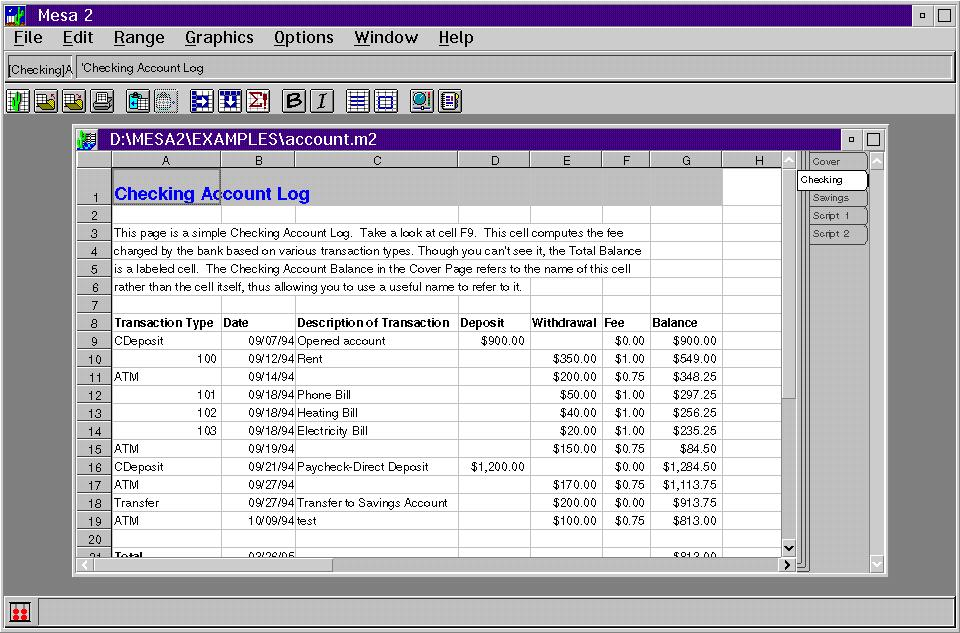|
SCOUG OS/2 For You - April 1995Mesa 2 for OS/2; A Mini-Review
Since then, OS/2 spreadsheets have been most notable by their absence. Lotus has continued to develop 1-2-3 (now in its fourth iteration), building on the multi-layered technology and the Solver- BackSolver technology which were both introduced with 1-2-3/G. And the FootPrint/Works-IBMWorks suite has delivered a capable, if somewhat spartan contender in the spreadsheet arena. But spreadsheet development, by and large, has not been particularly dynamic for the OS/2 environment. Mesa 2 is New Recently, however, a new entry has surfaced, and one which shows considerable promise for the future. That entry is Mesa 2 for OS/2 from Athena Design. Mesa 2 is not exactly a port, although its ancestry can be traced to the Mesa spreadsheet for the Next system. It has been designed to be Workplace Shell-aware and to exploit OS/2's other attributes. At this stage of its development, it provides an adequate level of functional capability, and some definite promise for future development. There is no doubt that Mesa 2 is still in Release 1 (even though it is officially identified as "Release 2" - Release 1 was the Next version), but it is remarkably free of bugs and the company is providing an excellent level of support. At this stage of development, the program seems to be a bit spartan, but there is a great deal of promise for growth in the features it presents. It does the classical spreadsheet kinds of things - doing data analysis and presenting data in an easy-to-understand format. But it definitely is not in the classical mold of Lotus 1-2-3. Mesa 2 Takes a Novel Approach The basic paradigm in Mesa 2 is the workbook. It provides an inherently multi-layered spreadsheet. Each workbook "page" is a separate spreadsheet layer which can be given a meaningful name. The income "page" of a general ledger spreadsheet application can be named Income; the expenses "page" can be named Expenses; and the page used to summarize financial status can be named Summary. Ranges can be defined and named on each "page" and these ranges can be referenced from anywhere else in the workbook. This means that, with very little effort, the data displayed on the Summary page can automatically be updated from other pages in the workbook. 
Speaking of ranges, Mesa 2 provides a very contemporary set of range fill and smart-fill capabilities. Smart fill understands a variety of object types, including number sequences, days of the week, months of the year, and the like. You can smart-fill a range with the sequence "January 10, February 10, March 10, etc." If you change "January 10" to "January 15" all the other fills in the sequence automatically update. And, of course, you can use drag-and-drop operations to move or copy a range from one place to another on the same "page." Unfortunately, in this release of the program, you can't drag the range between "pages" but they can be transferred using the clipboard. The word "graphic" actually has three meanings in Mesa 2. A variety of basic shapes - squares and rectangles, ovals and circles, arrows and lines, etc. - are available as menu options. These can be used to add emphasis to the contents of a workbook. There is a built-in graphing package that provides an adequate set of data graphing capabilities - twelve types of flat charts and four 3D charts - for data in ranges anywhere in the workbook. Once created, a graph continues to reflect the current contents of the range it represents. When the range is updated, so is the graph. It is also possible to import a variety of .BMP graphic objects into the workbook. Once any graphic object exists in a workbook, it can be turned into a "tool" which executes some series of commands. The commands are contained in "script" files. Mesa 2 uses REXX as the scripting language. This means that the full programming power of OS/2 REXX, including any extensions you may have registered (such as the RXUTIL package) can be used within the confines of a Mesa 2 workbook. In addition to the full power of REXX, Mesa 2 provides a total of 23 MScriptE functions which provide specific access to various aspects of a workbook. Together, these provide a potent capability for automating many aspects of Mesa 2 operation and for performing very complex operations. This also means that the capabilities of Mesa 2 can be extended beyond the boundaries of the program. Any operation that can be invoked by a REXX call, including the initiation of others processes, can, potentially, become a part of a Mesa 2 application. The Bottom Line So, where does Mesa 2 position as a product? I think there is a lot of promise in that flat-top mountain. At this stage of development, it doesn't qualify as "best of breed" and it is definitely at the beginning of its life-cycle. That not withstanding, it is a highly competent program with some capabilities that are unique. The range of tools within the product are, at present, a bit sparse, but in compensation you can use nearly any other OS/2 tool that can accept input from a REXX program. Mesa 2 is a good program now, and it holds the promise of becoming much better. If you are interested Athena Design is at 17 St. Mary's Court, Boston, MA 02146. They can be reached at 617-734-6372, or, to order Mesa 2, you can call 800-315-MESA. The product is also available locally at Office Solutions in Long Beach and through Indelible Blue.
P.O. Box 26904 Santa Ana, CA 92799-6904, USA Copyright 1995 the Southern California OS/2 User Group. ALL RIGHTS RESERVED. SCOUG is a trademark of the Southern California OS/2 User Group.
|








